Odisha State Board CHSE Odisha Class 12 Biology Solutions Chapter 14 Organisms and Environment Textbook Questions and Answers.
CHSE Odisha 12th Class Biology Chapter 14 Question Answer Organisms and Environment
Organisms and Environment Class 12 Questions and Answers CHSE Odisha
Very Short Answer Type Questions
Multiple choice questions
Question 1.
A population is a group of
(a) individuals in a species
(b) species’in a community
(c) individuals in a family
(d) communities in an ecosystem
Answer:
(a) individuals in a species
Question 2.
Exponential growth occurs when there is
(a) a great environmental resistance
(b) a fixed carrying capacity
(c) no biotic potential
(d) no environmental resistance
Answer:
(d) no environmental resistance
Question 3.
In a population, unrestricted reproductive capacity is called as
(a) carrying capacity
(b) birth rate
(c) biotic potential
(d) fertility rate
Answer:
(b) birth rate
![]()
Question 4.
Two opposite forces operate in the growth and development of a population. One of them is related to the ability to reproduce at a given rate. The force opposite to it is called
(a) environmental resistance
(b) mortality
(c) fecundity
(d) biotic control
Answer:
(b) mortality
Question 5.
The carrying capacity of a population is determined by its
(a) population growth rate
(b) mortality
(c) limiting resources
(d) natality
Answer:
(c) limiting resources
Question 6.
Which of the following at a conduit for energy transfer across trophic levels?
(a) mutualism
(b) parasitism
(c) protocooperation
(d) predation
Answer:
(d) predation
Question 7.
Phenomenon of inhibition of growth of one species by other species through secretion of some chemicals is termed as
(a) commensalism
(b) allelopathy
(b) mutualism
(d) predation
Answer:
(b) allelopathy
Question 8.
Predation performs all, except
(a) transfer of energy
(b) loss of sense organs
(c) keeps prey population under control
(d) maintains species diversity
Answer:
(b) loss of sense organs
Question 9.
Two important factors that influence the life of organisms are
(a) soil, temperature
(b) soil, light
(c) light, water
(d) water, temperature
Answer:
(c) light, water
Question 10.
Ecology describes
(a) interactions between living organisms only
(b) intraspecific competitions only
(c) interactions between members of single species
(d) interactions of organisms and abiotic components around
Answer:
(d) interactions of organisms and abiotic components around
![]()
Express in one or two words
Question 1.
Study of interrelationship between the environment and a plant species.
Answer:
Ecology
Question 2.
Amount of water vapours actually present in the air at any given time.
Answer:
Humidity
Question 3.
The total amount of water in the soil, except the gravitational water.
Answer:
Holard
Question 4.
Association of fungi and algae.
Answer:
Lichen
Question 5.
The study of soil.
Answer:
Pedology
Question 6.
Vegetation where the annual rainfall is more than 50 inches.
Answer:
Grassland
![]()
Correct the sentences changing the underlined word only
1. Plants those grow in soil and mud are xerophytes.
Answer:
mesophytes
2. Sunken stomata is a characteristic of hydrophytes.
Answer:
xerophytes
3. Air pockets are found in mesophytes.
Answer:
hydrophytes
4. The pre-reproductive mass is found more in urn- shaped pyramid.
Answer:
triangular
5. Population consists of different kinds of species.
Answer:
Community
Fill in the blanks
1. Shallow water region present on the edge of lakes is called …………. .
Answer:
littoral zone
2. The most relevant ecological factor is …………….. .
Answer:
light
3. Mortality and …………. contribute to a decrease in population density.
Answer:
emigration
4. J-shaped curve represents ………… growth.
Answer:
exponential
![]()
5. Geometric representation of age structure is a characteristic of ………..
Answer:
population
Short Answer Type Questions
Question 1.
Camouflage
Answer:
Camouflage It is the act of hiding the identify either by colour changes or by making animals or objects hard to see.
Some species of insects and frogs are cryptically coloured (camouflaged) to avoid being detected easily by predators.
Question 2.
Edaphic factor
Answer:
Edaphic factor An edaphic factor relating to physical or chemical composition of the soil found in a particular area, e.g. soil pH, porosity, water holding capacity, etc.
Question 3.
Habitat
Answer:
Environment is termed as sum total of all external conditions which influence the organisms in term of survival and reproduction. Habitat is a natural abode or locality where a plant/ animal grow, based on the environment, the differences in the vegetation and species of different places are observed.
Each organism plays an important role in its surrounding. Niche is the role of an organism plays in its ecosystem. In other words, we can say that niche is how an organism makes a living, interacts with other organisms and helps in cycling of nutrients.
Question 4.
Temperature
Answer:
Temperature
It is the most ecologically significant environmental factor. It varies seasonally on land and decreases progressively from the equator towards the poles and from plains to the mountain tops. It ranges from sub-zero levels in polar areas and high altitudes to > 50°C in tropical deserts in summer. There are also certain unique habitats such as thermal springs, deep sea hydrothermal vents where the average temperature exceeds 100°C.
Question 5.
Biomes
Answer:
Biomes The large unit of ecology which consist of major vegetation type and associated fauna in a particular climatic zone is called biome, e.g. sea coast, deserts. Deciduous forest are the major biomes of India.
Question 6.
Population
Answer:
The term ‘population’ can be defined as a group or assemblage of organisms of the same species living in a particular area at a given time.
For example, the lion population of the Gir forest or the peacock population of India, etc.
The population may be subdivided into demes or local populations, which are a group of interbreeding organisms. It is the smallest collective unit of a plant or animal population.
The other is metapopulation, which consists of whole set of local populations connected by dispersing individuals.
![]()
Question 7.
Competition
Answer:
It is generally believed to occur when closely related the two individuals of species compete for the same resources that are limiting. This can happen between the members of the same species, i.e., intraspecific or different species, i.e. interspecific.
Question 8.
Abiotic factors
Answer:
Abiotic factors The non-living factors which influence an ecosystem and the organisms are called abiotic factors. It can determine which species of organism will survive in an given environment.
Question 9.
Population density
Answer:
Population Density
This refers to the size of population to a unit space at a particular time. This can be measured is several ways an mentioned below
- Abundance (absolute number in population).
- Numerical density (number individuals per unit area).
- Biomass density (biomass per unit area).
Question 10.
Necessity of adaptations
Answer:
Necessity of adaptations Adaptations take a lot of time to evolve. They are necessary because they help the organism to fit in to its niches. Also, it is important for’ survival of both, the individual and the species.
Differentiate between the following
Question 1.
Habitat and Niche
Answer:
Differences between habitat and niche are as follows
| Habitat | Niche |
| A place or part of an ecosystem, occupied by a particular organism. | A functiohal description of the role, a species plays in a community. |
| It can have number of niches. | It does not have any components. |
| A variety of environmental variables are present in a habitat. | Every niche has its own specific environment. |
Question 2.
Mutualism and Parasitism
Answer:
Differences between mutualism and parasitism are as follows
| Mutualism | Parasitism |
| It type of interaction in which both the interacting species gets benefits. | The mode of interaction in two species in which one (parasites) is dependent on another for benefits there by damaging the other one (host). |
| Mycorrhiza show mutual association between fungi and roots of higher plants. | Human liver-fluke depends on two intermediate hosts to complete its life cycle. |
![]()
Question 3.
Hydrophytes and Xerophytes
Answer:
Differences between hydrophytes and xerophytes are as follows
| Hydorphytes | Xerophytes |
| The plants which are adapted to live in abundance of water are called hydrophytes. | The plants which are adapted to live in condition of water scarcity and dry habitat are called xerophytes. |
| Root are poorly developed. | Roots are very well- developed. |
| Leaves are well-developed. | Leaves are modified in various structure. |
| Stomata are present abundantly. | Sunken stomata are present. |
| e.g. Hydrilla, Pistia. | e.g. Opuntia, Asparagus, etc. |
Question 4.
Birth rate and Death rate
Answer:
Differences between birth rate and death rate are as follows
| Birth rate | Death rate |
| It is the number of birth of new individuals per unit of population per unit time. | It is the number of loss of individuals per unit of population per unit time. |
| It increases the size of population. | It decreases the size of population. |
Question 5.
Fertility and Fecundity
Answer:
Differences between fertility and fecundity are as follows
| Fertility | Fecundity |
| Fertility is the natural ability to reproduce and is defined as the offspring per couple. | Fecundity is the actual reproductive rate of an organism or population measured by number of gametes, (seed sets or asexual propagules). |
Question 6.
Logarithmic and Exponential growth
Answer:
Differences between logarithmic and exponential growth are as follows
| Logarithmic growth | Exponential growth |
| Logistic or Logarithmic occurs rapidly and then slow down. | The kind of growth which is slow initially but, it increases as the population growth takes place. |
| It considers factors like competition and limited resources. | It requires specific ideal conditions to occur. |
| It occurs when the resources are limited. | It occurs when the resources are abundant. |
| It has four phases-lag, log, decelearatlon and steady. | It has two phases-lage and log. |
| It is more common, in human, etc. | It occurs in algal bloom, etc. |
![]()
Long Answer Type Questions
Question 1.
Explain, what is population? Describe the different characteristics of population.
Answer:
The term ‘population’ can be defined as a group or assemblage of organisms of the same species living in a particular area at a given time.
For example, the lion population of the Gir forest or the peacock population of India, etc.
The population may be subdivided into demes or local populations, which are a group of interbreeding organisms. It is the smallest collective unit of a plant or animal population.
The other is metapopulation, which consists of whole set of local populations connected by dispersing individuals.
Population Interactions:
In nature, living organisms such as animals, plants and microbes, cannot live in isolation and therefore, interact in various ways to form a biological community. Interspecific interactions occur between the populations of two different species living together within a community.
These interactions could be beneficial (+), detrimental (-) or neutral (0), as shown in table below
Population Interactions and their Effects
| Name of interaction | Effect on species-A | Effect on species-B |
| Mutualism | + | + |
| Competition | – | – |
| Predation | + | – |
| Parasitism | + | – |
| Commensalism | + | 0 |
| Ammensalism | – | 0 |
Mutualism:
It is an interaction that confers benefits to both the interacting species. Some examples of mutualism are
1. Lichens represent an intimate mutualistic relationship between a fungus (mycobiont) and photosynthesising algae (phycobiont) or cyanobacteria. Here, the fungus helps in the absorption of nutrients and provides protection, while algae prepares the food.
2. Mycorrhiza show dose mutual association between fungi and the roots of higher plants. Fungi help the plant in absorption of nutrients, while the plant provides food for the fungus, e.g. many members of genus -Glomus.
3. Plants need help from animals for pollination and dispersal of seeds. In return, plants provide nectar, pollens and fruits to them.
4. Co-evolution to safeguard the mutually beneficial system, plant-animal interactions involve co-evolution of the mutualists, i.e. the evolution of the flower and its pollinator species are tightly linked with one another, e.g.
(i) Fig and its partner wasp species, the female wasp uses the fruit not only as an oviposition (egg-laying) site, but uses the developing seeds from the fruit for nourishing its larvae. In return, the wasp pollinates the fig inflorescence, while searching for suitable egg-laying sites.
(ii) Mediterranean orchid Ophrys employs ‘sexual deceit’ to get pollinated by a species of bee. One petal of its flower bears an uncanny resemblance to the female of the bee in size, colour and markings. The male bee is attracted to what it perceives as a female and ‘pseudocopulates’ with the flower. During this process, pollen are dusted from the flower onto the male bee. When the same bee pseudocopulates with another flower, it transfers pollen to it and thus pollinates the flower.
Competition:
It is generally believed to occur when closely related the two individuals of species compete for the same resources that are limiting. This can happen between the members of the same species, i.e., intraspecific or different species, i.e. interspecific. These are as follows
(i) Intraspecific competition occur for the resources which are short in supply such as food, space or mate. There are of two types
- Content competition Where each organism claims a part of the resource, but due to competition, some are successful to get, but some fail.
- Scramble competition In this case, the resource gets divided to many other smaller parts to which all have access. Individual organism scramble for resources. Each individual succeeds to get some of the resource available to survive.
(ii) Interspecific competition It occurs between members of different species, e.g. competition is likely to have two outcomes. These are as follows
1. Competitive exclusion According to Gause’s competitive exclusion principle two closely related species competing for same resources cannot co-exist indefinitely and the competitively inferior species will be eliminated eventually two species of beetles (Tribolium castaneum and T. confusum) feed on stored flour, one species would survive and other will die.
2. Co-existence Species facing competition might evolve a mechanism to live in the same niche by changing the feeding time or foraging pattern. This is called resource partitioning.
Question 2.
What do you understand by population? Explain the different attributes of the population.
Answer:
The term ‘population’ can be defined as a group or assemblage of organisms of the same species living in a particular area at a given time.
For example, the lion population of the Gir forest or the peacock population of India, etc.
The population may be subdivided into demes or local populations, which are a group of interbreeding organisms. It is the smallest collective unit of a plant or animal population.
The other is metapopulation, which consists of whole set of local populations connected by dispersing individuals.
Population Attributes:
Population is a unit of ecosystem through which the energy flows and nutrients get cylced which helps in maintaining its stability. A population has some features such as birth rate, death rate, growth form, age structure, density, etc. which are discussed below
1. Growth
When a few organisms are introduced to a particular unoccupied area, the population show growth (increase in size) in sigmoid or ‘S’-shaped logistic fashion.
The few organisms are introduced to a particular unoccupied area, the growth of population initially is slow (positive acceleration phase). Then suddenly there is sharp increase and growth becomes vary rapid (logarithmic phase). At last stage it finally slow and down because of the increased environmental resistance (negative acceleration phase). It is dipicted in the given [fig. 14.19(a)], The increase of population size does not occure beyond a certain saturation limit. This is known as carrying capacity .
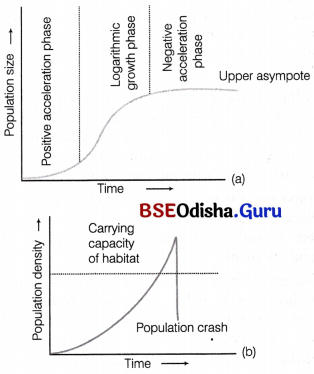
The sigmoid and exponential growth curves
Another kind of population curve in J-shaped this the density of organism increase rapidly, but stops suddenly due to environmental resistance. It is called exponential growth curve.
(i) Growth Rate:
The growth rate of a population can be determined by the following formula

Population size for a given species is not static parameter, but it is ever changing based on different factors including food availability, predation pressure and weather diversity. The population thickness changes because of the following four changes
- Natality It refers to the number of “births during a given period in the population that are added to the initial density.
- Mortality It is the number of deaths in the population during a given period.
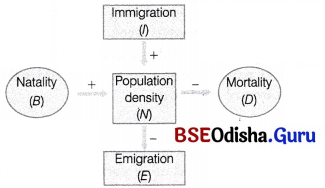
Factors influencing population density
2. Birth Rate and Death Rate:
The increased and decreased rate of population depends on birth and death natality is related new homes, i.e. the reproduction capacity of individuals. It is related with two aspects of reproduction.
Thus, natality or birth rate of a population can be expressed as

Where, b = Natality per unit time, d – Changing value of the entity, N = Initial number of individuals in population, Nn – Number of new individuals added and t = Unit time.
Similarly, the death rate or mortality rate is the death or loss of individuals from the population in unit time and can be expressed as

The death rate has a relation with the natality because of over crowding, predation and spread of disease.
3. Sex Ratio:
It represents the ratio of organisms of different sexes of the population. In animals, sex is either male or female which creates difference in the characteristic of the population.
4. Age Distribution:
A population at a given time is composed of individuals of different age groups such as pre-reproductive, reproductive and post-reproductive. The population age distribution is related to the growth rate of the population and this can be used to calculate whether the population is expanding or contracting.
Ordinarily, a rapidly expanding population would have a large proportion of young individuals, a stationary population with even distribution of age groups and declining population contain a large proportion of old individuals.
These age groups of the population can be portrayed through the graphical age pyramid representations.In human population, the age pyramids generally express age distribution of males and females in a combined diagram. The shapes of the pyramids reflect the growth status of the population.
The pyramids can be of three difference types as follows
(i) Expanding (Triangular) This is a type of a growing population representation is like a triangle.
The population carries a high proportion of pre-reproductive individuals followed by reproductive individuals and post-reproductive individuals. Because of the very large number of pre-reproductive individuals, more and more of them enter reproductive phases and rapidily increases the size of the population.
(ii) Stable (Bell-shaped) This type of pyramid will represent a stationary or stable population having an equal number of young and middle aged class of individiuals.
(iii) Declining (Urn-shaped) This group has a small number of pre-reproductive individuals followed by a large number of reproductive individuals. As, there is less number of individuals in pre-reproductive groups.
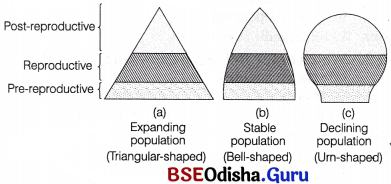
5. Population Density
This refers to the size of population to a unit space at a particular time. This can be measured is several ways an mentioned below
- Abundance (absolute number in population).
- Numerical density (number individuals per unit area).
- Biomass density (biomass per unit area).
The density of population can be expressed in the following manner
(a) Crude density This is the density of a species population with reference is the total area. It varies according to the season, weather, food supply rate of reproduction, etc.
(b) Ecological density This is the density of a species with reference to the actual area of habitat available to the species.
Question 3.
Explain, how different organisms interact in a population emphasising on the possibilities of various relationships.
Answer:
The term ‘population’ can be defined as a group or assemblage of organisms of the same species living in a particular area at a given time.
For example, the lion population of the Gir forest or the peacock population of India, etc.
The population may be subdivided into demes or local populations, which are a group of interbreeding organisms. It is the smallest collective unit of a plant or animal population.
The other is metapopulation, which consists of whole set of local populations connected by dispersing individuals.
Predation
It is an interspecific interaction, where an animal called predator kills and consumes the other weaker animal called prey. This is a biological control method. It is the nature’s way of transferring energy to higher trophic levels, which is fixed by plants at the first trophic level, e.g. tiger (predator) and deer (prey).
Important roles of predators are as follows
1. In the absence of predators, prey species could achieve very high population densities and cause instability. So, besides acting as ‘conduits’ for energy transfer across trophic levels, predators play very important role in providing population stability.
2. They help in maintaining species diversity in a community, by reducing the intensity of competition among competing prey species, e.g. predator starfish Pisaster in the rocky intertidal communities of American Pacific Coast. In a field experiment, when all the starfish were removed from the area, more than 10 species of invertebrates became extinct within a year, because of interspecific competition.
3. When certain exotic species are introduced into a geographical area, they become invasive and start spreading fast because the invaded land does not have natural predators, e.g. prickly pear cactus introduced in Australia in early 1920s was brought under control by introducing its predator (i.e. a moth) in the country.
If a predator is too efficient and over exploits its prey, then the prey might become extinct.
Following it, the predator will also become extinct because of the lack of food. This is why predators in nature are prudent.
Prey species have evolved various defence mechanisms to lessen the impact of predation. These are as follows
In Animals:
- Camouflage Some species of insects and frogs are cryptically coloured (camouflaged) to avoid being detected easily by the predator. Some are poisonous and therefore, avoided by the predators.
- Chemical emission Monarch butterfly is highly distasteful to its predators (birds) because of a special chemical present in its body. The butterfly acquires this chemical during its caterpillar stage by feeding on a poisonous weed.
- Mimicry It refers to the resemblance of an organism to their natural surroundings which hides them from eyes of predators.
In Plants
Nearly 25% of all insects are known to be phytophagous (feeding on plant sap and other parts of plants) apart from other herbivores. So, plants have evolved various defences against them, e.g., thorns of Acacia and cactus are the most common morphological means of defence.
Some plants produce highly poisonous chemicals like cardiac glycosides, e.g., weed Calotropis that makes the herbivore sick, etc.
Chemicals like nicotine, caffeine, quinine, strychnine, opium, etc., are actually defence mechanisms against grazers and browsers.
Parasitism:
It is the mode of interaction between two species in which one species (parasite) depends on the other species (host) for food and shelter and damages the host. In this process, one organism is benefitted (parasite), while the other is being harmed (host).
(i) Adaptation methods of a parasite are
Parasite is host-specific in a way that both host and parasite tend to co-evolve. According to its lifestyle, a parasite, evolved special adaptations as
- Loss of unnecessary sense organs.
- The presence of adhesive organs or suckers for clinging on to host.
- Loss of digestive system.
- High reproductive capacity.
(ii) The life cycles of parasites are often complex, involving one or two intermediate hosts or vectors to facilitate parasitisation of its primary host,, e.g.
- Human liver fluke (a trematode parasite) depends on two intermediate hosts (a snail and a fish) to complete its life cycle.
- Malarial parasite (Plasmodium) needs a vector (mosquito) to spread to other hosts.
(iii) Majority of parasites harm the host. The harm is done in the following ways
- They reduce the survival, growth and reproductive ability of the host.
- They reduce its population density.
- They might render the host more vulnerable to predation by making it physically weak.
Types of Parasites
Parasites are broadly divided into following main types
- Ectoparasites depend on the external surface of the host organism for food and shelter, e.g., lice on humans, ticks on dogs, copepods in marine fishes and Cuscuta, a parasitic plant that grows on hedge plants.
- Endoparasites live inside the host’s body at different sites like liver, kidney, lungs, etc., for food and shelter, e.g. tapeworm, liver fluke, Plasmodium, etc. The life cycles of endoparasites are more complex because of their extreme specialisation.
- Brood parasitism is an example of parasitism in which one organism (parasite) lays its eggs in the nest of another organism (host) for the later to incubate them.
The eggs of parasitic birds have evolved to resemble the host’s egg to reduce the chances of host bird from detecting and ejecting the parasitic eggs from nest, e.g., cuckoo (koel, parasite) and crow (host) during breeding season (spring to summer).
Effects of Parasites on Host
There always exist some kind of host parasite relationship which has following characteristics parasites do not kill the host immediately, but they make the host to suffer, they damage their body and in extreme case they may cause their death. These reduce the growth of the host and also afffect their reproductive potential. They also reduce the size of the population of host.
Question 4.
What is habitat? Describe the different types of abiotic factors present in the habitat.
Answer:
Habitat:
Environment is termed as sum total of all external conditions which influence the organisms in term of survival and reproduction. Habitat is a natural abode or locality where a plant/ animal grow, based on the environment, the differences in the vegetation and species of different places are observed.
Abiotic Factors:
These include climatic, edaphic and topographic factors. Climatic factors are light, temperature, precipitation, humidity, wind. Edaphic factors are factors related to soil whereas topographic factors are physical factors related to slope, altitude and others concerned with earth surface. Some of the major abiotic factors are discussed below
1. Light
Sunlight is the primary source of light. It plays an important role in almost all ecosystems. The entire food chain starts with the organisms that are photosynthetic (producers).
So without sunlight, all life excluding some microbes would perish, not just the plants. The total amount of light that falls on the earth varies according to the season, latitude, altitude and conditions of the atmosphere. The significance of light lies in the fact that all autotrophs depend upon light as a source of energy for preparing their food by photosynthesis and release oxygen during the process.
Therefore, it is an important factor for life to exist on earth. Small herbs and shrubs growing in forests are adapted to photosynthesis under very low light intensities, because they are overshadowed by the tall, canopied trees. Most plants depend on sunlight to meet their photoperiodic requirement for flowering also.
The spectral quality of solar radiation as shown in figure is also important for life. The UV component of light is harmful for many organisms. Different components of the visible spectrum are available for marine plants living at different depths of the ocean.

This is why different types of algae, i.e., green, brown and red algae occur at different depths in sea in the upper, middle and deep layers of water respectively.
Plants which grow in bright light are called sun plants or heliophytes while plants growing in shade or low intensity light are called sciophytes.
Depending upon the availability of light aquatic body is divided into the following zones
- Littoral zone ft adjoins the shore and extends to the point water body when producers (plants) show the light compensation level. The point indicate the rate of photosynthesis equalising with the rate of respiration.
- Limnetic zone It is the major open area of waterbody next to the littoral zone. The O2 availability to the organisms living in this area is from the photosynthetic activity of phytoplanktons and in the atmosphere immediately over the water or lake’s surface.
In the limnetic zone, the region which gets the maximum light above the light compensation point is called euphotic zone.
The region where light is received less and diffused and is below the light compensation point is disphotic zone. - Profundal zone This is the bottom area of the pond, where respiration is greater than production.
- Benthic zone It is the zone of darkness. No light, penetrate in the deeper layers of waterbody. The organism living here in this zone have poorly developed eye sight. The producers are mainly chemosynthetic bacteria.
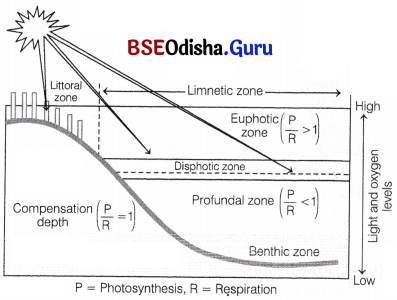
Zonation in deep lake showing gradient of light and oxygen
2. Temperature
It is the most ecologically significant environmental factor. It varies seasonally on land and decreases progressively from the equator towards the poles and from plains to the mountain tops. It ranges from sub-zero levels in polar areas and high altitudes to > 50°C in tropical deserts in summer. There are also certain unique habitats such as thermal springs, deep sea hydrothermal vents where the average temperature exceeds 100°C.
Physiological functions as well as geographical distribution of plants and animals are governed by the temperature conditions and their thermal tolerance. Organisms which can tolerate and thrive in a wide range of temperatures are called eurythermal, e.g., most mammals and birds while organisms which can tolerate a narrow range of temperatures are called stenothermal, e.g., polar bear, amphibians.
3. Precipitation
Rainfall and hail storm are two major forms of precipitation. The only available form of water to the plant is the soil water. So, precipitation is indirect form of water which affect the plant life and water content of ‘ the soil. The vegetation of an area is directly or indirectly affected by the precipitation received by that area.
4. Soil
The nature and properties of soil in different places vary significantly. It is dependent mainly on the following factors
- Climate
- Weathering process
- Whether soil is transported or sedimentary
- Soil development process
Water holding capacity and percolation of the soil is determined by its various characteristics, such as soil composition, soil particle size and aggregation of soil particles.
These characteristics of soil along with its pH, mineral composition, topography, etc., determine the type of plants that can grow in a particular habitat and the type of animals that can feed on them. In aquatic environment also, the bottom sediments and its characteristics determine the type of benthic animals that can live there. Thus, the key abiotic factors affecting the organisms.
Besides these prominent abiotic factors, biotic factors are also forming a habitat and are the part of ecological environment.
Question 5.
What are the various adaptations different plants adapt for their survival in different habitats?
Answer:
Adaptations in Hydrophytes
Adaptations in hydrophytes can be discussed under three headings, i.e. morphological, anatomical and physiological.
1. Morphological Adaptations
Hydrophytes show various kinds of structural adaptations in their roots, stems and leaves.
(i) Root
- Roots may be entirely absent, e.g. Woljfia, Salvinia or poorly developed, e.g. Hydrilla.
- Roots are well-developed with distinct root caps, e.g. Ranunculus (emergent hydrophytes), aerenchymapresent.
- In Eichhornia root caps are replaced by root pockets.
- Some plants, i.e. Jussiaea have two types of roots, one is normal type and other is spongy and negatively geo trophic.
(ii) Stem
- In Hydrilla, Potamogeton, the stems are slender spongy flexible.
- Horizontal stems are found in floating hydrophytes like Azolla, Pistia or Eichhornia.
- In rooted hydrophytes like Sagittaria, Cyperus, Scirpus, the stem is rhizome or stolon.
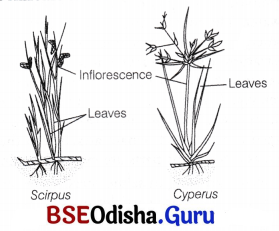
Stolon stems in marshy plants
(iii) Petioles
Some hydrophytes show special features in the petioles.
- Petioles in submerged plants, with free-floating leaves like Nymphaea and Nelumbium, are long, slender and spongy.
- In the free-floating hydrophyte Eichhornia, stems are long slender and spongy.
- In the free-floating hydrophyte Eichhornia, the petiole is swollen have big air spaces in side tissues and helps in floating.
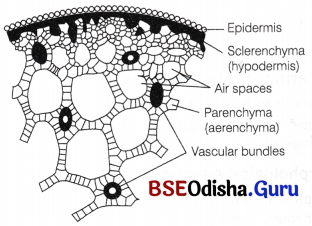
TS of petiole of Eichhornia
(iv) Leaves
The structural details of hydrophytes show number of variations, which can be summerised as follows
- In Vallisneria the leaves are long and narrow.
- These are finely dissected in Utricularia, Myriophyllum and Ceratophyllum. This helps aquatic plants to provide little resistance against water.
- The free-floating hydrophytes have wax coating on than, these are shiny and smooth. Wax coating present dessication of leaves in water scarce condition.
- In Nelumbium and Nymphaea the leaves remain in touch with water surface and upper layer is exposed to the air.
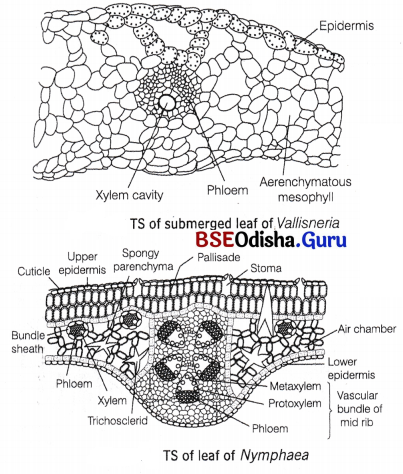
The amphibions hydrophytes exhibit the phenomenon of heterophylly (two types of leaves). The submerged leaves are dissected to go with’water currents while above water are broad, e.g. Sagittaria, Ranunculus, Limnophylla heterophylla.
2. Anatomical Adaptations
Hydrophytes show the following anatomical features
(i) Reduction in Protecting Structures
- Cuticle is absent in submerged portion.
- Epidermis has chloroplast, used as photosynthesising organ.
- Hypodermis is poorly developed.
(ii) Reduction of Mechanical Tissue
- Sclerenchyma is absent or poorly developed in submerged portions.
- Asterosclereids is present that provide mechanical support in case sclerenchyma is absent.
- Sclerenchyma present only in aerial tissues.
(iii) Reduction of Conducting Tissue
- Vascular bundles are reduced to few or even one, e.g Hydrilla.
- Xylem cells are very few.
- Phloem is usually poorly developed, but in some cases it is well-developed.
- Secondary vascular tissue is totally absent.
(iv) Increase in Aeration
- Stomata are totally absent or poorly developed in submerged parts.
- If present, stomata are confined to upper surface leaves.
- In amphibious plants, stomata are scattered on the aerial portions.
- Roots, stems and leaves of most hydrophytes have parenchymatous tissue with air chambers. These chambers store gases like CO2 and O2 and help in respiration and photosynthesis. These are hence, called aerenchyma. Besides, the air chambers help in buoyancy and provide mechanical support.
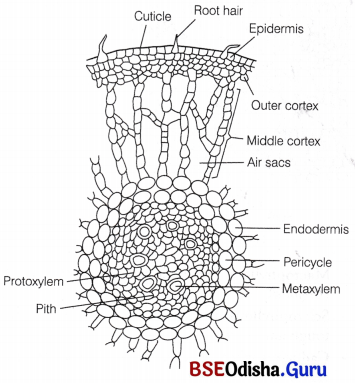
TS of root of Typha
3. Physiological Adaptations
Besides their adaptations in the morphological and anatomical characters, hydrophytes also show physiological adaptations.
- Osmotic concentrations of cell sap is low.
- Photosynthetic and respiratory gases are retained in air chambers for further use.
- No transpiration occurs in submerged plants.
- In hydrophytes, mostly vegetative reproduction.
Xerophytes:
These are the plants which are adapted to drier regions and have high rate of transpiration than absorption of water.
Types of Xerophytes
Xeric habitats are of two types
(i) Physically dry habitats are those in which water cannot be retained (deserts, rock surface).
(ii) Physiologically dry habitats have plants of water, but the water is not available to the plant.
Based on their adaptation to water scarcity or drought conditions, xerophytes are of three types
- Drought resistant plants are such that they can survive in extreme conditions, drought enduring plants can tolerate drought though they may hot have adaptation.
- Drought enduring plants these do not have distinct adaptation.
- Drought escaping plants these are short lived plants, complete the life cycle before the arrival of dry condition, e.g. Artemisia, Astragalus.
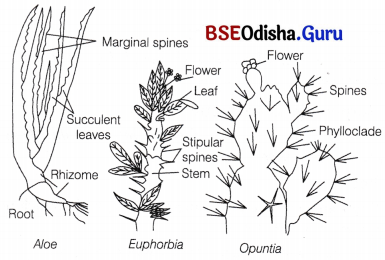
Succulents xerophytes
Based on their capacity to store water, xerophytes are classified as succulents and non-succulents. Succulents like Opuntia, have their organs swollen due to accumulation of water, whereas non-succulents are considered as true xerophytes.
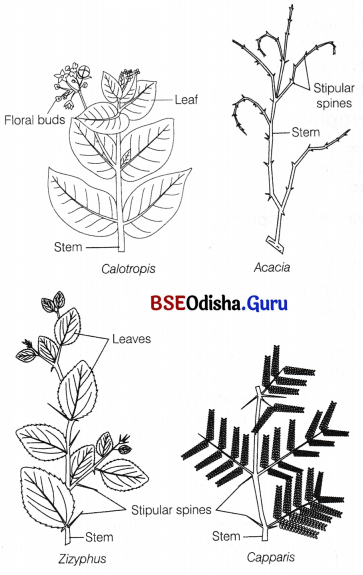
Adaptation in Xerophytes:
These show varied adaptions in the morphology, anatomy and physiology which are as follows
1. Morphological Adaptations
Xerophytes exhibit a number of special features in their body organs as given below
(i) Roots
- Roots are very extensive, long tap roots, with branching spread over wide areas.
- Root hairs and root caps are very well-developed.
(ii) Stem
- Stems are stunted, woody, dry, hard and covered with thick waxy cuticle.
- In Opuntia stem becomes green and fleshy (phylloclade).
- On stems and leaves, there are hairs and waxy coatings.
- Succulents have their stem modified into leaf-like structures called cladodes as in Asparagus.
(iii) Leaves
The leaves of xerophytes are reduced to spines to various structures. This helps plants to reduce rate of respiration. The following types of leaf conditions are seen
- Microphyllous when leaves are scaly (Casuarina) and needle-like Pinus.
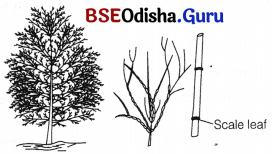
- Trichophyllous when leaves are covered with hairs (.Nerium, Calotropis).
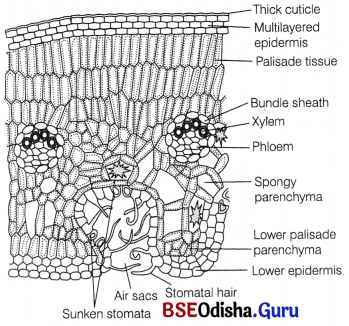
- Macrophyllous when leaves are soft and flesh (Begonia).
- Sclerophyllous plants showing leaves which are tough and hard.
- Cadueous when leaves fall early, i.e. plants with no leaves.
- Rolling leaves in ammophilis stomata are directed in words.
Anatomical Adaptations:
These adaptations can be conveniently discussed under the headings, i.e. epidermis, hypodermis and vascular tissue.
(i) Epidermis
- Some xerophytes have multiple epidermis, e.g. Nerium.
- It has thick cuticle and deposition of waxes, resins, etc.
- Epidermal hairs are present in grooves.
- Some leaves have bulliform cells that help in rolling.
- The stomata are present in sunken pits to reduce transpiration rate.
- Stomatal frequency is very low in xerophytes.
(ii) Hypodermis
It is thick and well-developed and is made up of parenchymatous cells.
(iii) Ground Tissue
- In stems, there is abundant mechanical tissue in the form of sclerenchyma, e.g. Casuarina.
- Since, leaves are reduced, the stems usually have chlorenchyma.
- In succulent plants, cortex is filled with water, mucilage, latex, etc.
- In plants that have leaves, palisade parenchyma is well-developed.
- In Pinus, mesophyll cells are modified.
- Intercellular spaces are greatly reduced.
(iv) Conducting Tissue
Vascular tissue (xylem and phloem) .is very well-developed in xerophytes.
3. Physiological Adaptations
- Osmotic concentration of the cell sap is very high.
- Succulents have high pentosan (chemicals derived from polysaccharides) resulting in accumulation of water.
